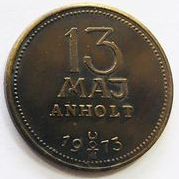
PREV ARTICLE
FULL ISSUE
PREV FULL ISSUE
HOAX 'DEVIL COINS' FOUND AT BATH ABBEYMany thanks to Arthur Shippee, who forwarded several articles from today's issue of The Explorator newsletter. In the
bizarre-but-true department is this Exorcist-movie-style story of an archaelogist's weird discovery as told by a local paper in Bath, England.
-Editor
  Archaeologists working at Bath Abbey have discovered coins with the image of the devil on them which links Bath to a conspiracy stretching back 40 years. The coins were discovered by a team from Wessex archaeology during recent works to repair the Abbey’s floor. The archaeologists found “a few interesting artifacts” hidden underneath a raised platform including some old pocket change dropped by worshippers and an order or service from 1902. But when the team took a closer look at some of the coins they had found they were astounded to see they weren’t any kind of known currency, instead showing an image of Satan and mysterious Latin writing. Project manager Bruce Eaton said: “What no one had expected to find were two coins, depicting a devil and bearing the words CIVITAS DIABOLI [country or citizenry or the devil] on one side and, on the reverse, 13 MAJ ANHOLT 1973 [13 March Anholt 1973].” Naturally the archaeologists were intrigued and started researching the coins. What they found was the bizarre story of a Danish eccentric who masterminded an elaborate 40-year-long hoax which was only unmasked a decade after his death. To read the complete article, see: Here's more from The Independent. -Editor
Sometimes referred to by Scandinavians as “the prank of the century”, the elaborate and extraordinary hoax began on the remote Danish island of Anholt. In May 1973, at around the time of a full moon, islanders began finding signs of Satanic rituals in an isolated area they called “the desert”. As the Norwegian academic Jesper Aagaard Petersen later wrote – in a paper entitled Operation Mindf***, Viking Edition – there were Polynesian-looking masks, bones wrapped in string, and a fake human head on a stake that was planted in the sand through a child’s sandal strap. A police officer was ordered to take the ferry from the mainland to Anholt (some six months before the release of the film The Wicker Man, starring Edward Woodward as a detective sent to investigate strange goings on a small Scottish island). The (non-fictional) Danish policeman carefully catalogued and photographed the items, while talking to the islanders. Some seemed terrified. One told the policeman she was now frightened to go out at night because “you can never know if the devils want to see blood”. And then, as the first wave of “Satanism on Anholt” stories started dying down, the “devil coins” started appearing. For years, people kept on finding them: in church crypts, behind statues, even on one occasion behind paintings at the police headquarters in Copenhagen. So far, some 370 devil coins have been found, many in Denmark, but also abroad, in tourist destinations around Scandinavia. The Bath Abbey coins, though, are believed to be the first found in the UK. Strange letters were also discovered or sent. The director of Rosenborg Castle, home to the Danish crown jewels, received an outsize human tooth in the post. Sometimes the letters purported to be from the Satanic high priestess Alice Mandragora. On other occasions they came from a Karl Klunck or Dunk Wokgnal. To read the complete article, see: And here's a wrap-up from The Guardian. -Editor
In 2013, the Danish newspaper Politiken ran a six-part investigation into the coin phenomenon, revealing that the Anholt mystery was a hoax perpetrated by Knud Langkow, an office clerk at the National Gallery of Denmark who died in 2004, aged 73. His niece Lene Langkow Saaek told the newspaper he was not a satanist and the hoax was just his sense of humour. “I think normality annoyed him,” she said. ‘He did not like ordinary.” Some coins may have been minted by Langkow but others are thought to have been created by independent experts who were in on the joke. Bath’s Anholt coins are in the care of Wessex Archaeology and will be included in the final site archive, alongside artefacts dating from the Roman through to the modern period. To read the complete article, see: So... have any of these pieces found their way into the numismatic community? Have they been catalogued anywhere? -Editor
 Wayne Homren, Editor The Numismatic Bibliomania Society is a non-profit organization promoting numismatic literature. See our web site at coinbooks.org. To submit items for publication in The E-Sylum, write to the Editor at this address: whomren@gmail.com To subscribe go to: https://my.binhost.com/lists/listinfo/esylum All Rights Reserved. NBS Home Page Contact the NBS webmaster 
|